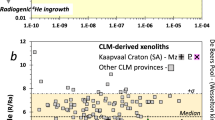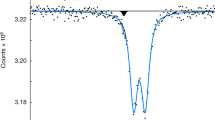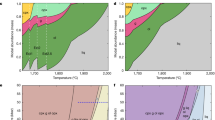Abstract
The infiltration of fluids into continental lithospheric mantle is a key mechanism for controlling abrupt changes in the chemical and physical properties of the lithospheric root1,2, as well as diamond formation3, yet the origin and composition of the fluids involved are still poorly constrained. Such fluids are trapped within diamonds when they form4,5,6,7 and so diamonds provide a unique means of directly characterizing the fluids that percolate through the deep continental lithospheric mantle. Here we show a clear chemical evolutionary trend, identifying saline fluids as parental to silicic and carbonatitic deep mantle melts, in diamonds from the Northwest Territories, Canada. Fluid–rock interaction along with in situ melting cause compositional transitions, as the saline fluids traverse mixed peridotite–eclogite lithosphere. Moreover, the chemistry of the parental saline fluids—especially their strontium isotopic compositions—and the timing of host diamond formation suggest that a subducting Mesozoic plate under western North America is the source of the fluids. Our results imply a strong association between subduction, mantle metasomatism and fluid-rich diamond formation, emphasizing the importance of subduction-derived fluids in affecting the composition of the deep lithospheric mantle.
This is a preview of subscription content, access via your institution
Access options
Subscribe to this journal
Receive 51 print issues and online access
$199.00 per year
only $3.90 per issue
Buy this article
- Purchase on Springer Link
- Instant access to full article PDF
Prices may be subject to local taxes which are calculated during checkout




Similar content being viewed by others
References
Carlson, R. W., Pearson, D. G. & James, D. E. Physical, chemical and chronologic characteristics of continental mantle. Rev. Geophys. 43, RG1001 (2005)
Griffin, W. L., O’Reilly, S. Y., Afonso, J. C. & Begg, G. The composition and evolution of lithospheric mantle: a re-evaluation and its tectonic implications. J. Petrol. 50, 1185–1204 (2009)
Shirey, S. B. et al. Diamonds and the geology of mantle carbon. Rev. Mineral. Geochem. 75, 355–421 (2013)
Navon, O., Hutcheon, I. D., Rossman, G. R. & Wasserburg, G. J. Mantle derived fluids in diamond micro inclusions. Nature 335, 784–789 (1988)
Tomlinson, E. L., Jones, A. P. & Harris, J. W. Co-existing fluid and silicate inclusions in mantle diamond. Earth Planet. Sci. Lett. 250, 581–595 (2006)
Klein-BenDavid, O., Izraeli, E. S., Hauri, E. & Navon, O. Fluid inclusions in diamonds from the Diavik mine, Canada and the evolution of diamond-forming fluids. Geochim. Cosmochim. Acta 71, 723–744 (2007)
Weiss, Y. et al. A new model for the evolution of diamond-forming fluids: evidence from microinclusion-bearing diamonds from Kankan, Guinea. Lithos 112, 660–674 (2009)
Creighton, S., Stachel, T., Eichenberg, D. & Luth, R. W. Oxidation state of the lithospheric mantle beneath Diavik diamond mine, central Slave craton, NWT, Canada. Contrib. Mineral. Petrol. 159, 645–657 (2010)
Rudnick, R. L., McDonough, W. F. & Orpin, A. in Kimberlites, Related Rocks and Mantle Xenoliths Vol. 1 (eds Meyer, H. O. A. & Leonardos, O. ) 336–353 (Proc. Fifth Int. Kimb. Conf., C.P.R.M., 1994)
Stachel, T. et al. The trace element composition of silicate inclusions in diamonds: a review. Lithos 77, 1–19 (2004)
Weiss, Y., Griffin, W. L., Bell, D. R. & Navon, O. High-Mg carbonatitic melts in diamonds, kimberlites and the subcontinental lithosphere. Earth Planet. Sci. Lett. 309, 337–347 (2011)
Klein-BenDavid, O. et al. The source and time-integrated evolution of diamond-forming fluids—trace element and Sr isotopic evidence. Geochim. Cosmochim. Acta 125, 146–169 (2014)
Weiss, Y., Griffin, W. L. & Navon, O. Diamond-forming fluids in fibrous diamonds: the trace-element perspective. Earth Planet. Sci. Lett. 376, 110–125 (2013)
Tomlinson, E. L., Müller, W. & EIMF A snapshot of mantle metasomatism: trace element analysis of coexisting fluid (LAICP-MS) and silicate (SIMS) inclusions in fibrous diamonds. Earth Planet. Sci. Lett. 279, 362–372 (2009)
Klinkhammer, G. P., Elderfield, H., Edmond, J. & Mitra, A. Geochemical implications of rare earth element patterns in hydrothermal fluids from mid-ocean ridges. Geochim. Cosmochim. Acta 58, 5105–5113 (1994)
Allen, D. E. & Seyfried, W. E. REE controls in ultramafic hosted MOR hydrothermal systems: an experimental study at elevated temperature and pressure. Geochim. Cosmochim. Acta 69, 675–683 (2005)
Bach, W. et al. The geochemical consequences of late-stage low-grade alteration of lower ocean crust at the SW Indian Ridge: results from ODP Hole 735B (Leg 176). Geochim. Cosmochim. Acta 65, 3267–3287 (2001)
Benoit, M., Polve, M. & Ceuleneer, G. Trace element and isotopic characterization of mafic cumulates in a fossil mantle diaper (Oman ophiolite). Chem. Geol. 134, 199–214 (1996)
Schmidt, M. W. & Poli, S. Generation of mobile components during subduction of oceanic crust. Treatise Geochem. 3, 567–591 (2003)
Nazzareni, S. et al. Synthetic hypersilicic Cl bearing mica in the phlogopite–celadonite join: a multimethodical characterization of the missing link between di- and tri-octahedral micas at high pressures. Am. Mineral. 93, 1429–1436 (2008)
van Achterbergh, E. et al. Subduction signature for quenched carbonatites from the deep lithosphere. Geology 30, 743–746 (2002)
Aulbach, S., Pearson, N. J., O'Reilly, S. Y. & Doyle, B. J. Origins of xenolithic eclogites and pyroxenites from the central Slave craton, Canada. J. Petrol. 48, 1843–1873 (2007)
Jacob, D. E., Dobrzhinetskaya, L. & Wirth, R. New insight into polycrystalline diamond genesis from modern nanoanalytical techniques. Earth Sci. Rev. 136, 21–35 (2014)
Shephard, G. et al. Circum-Arctic mantle structure and long-wavelength topography since the Jurassic. J. Geophys. Res. Solid Earth 119, 7889–7908 (2014)
Currie, C. A. & Beaumont, C. Are diamond-bearing Cretaceous kimberlites related to low-angle subduction beneath western North America? Earth Planet. Sci. Lett. 303, 59–70 (2011)
Jones, C. E. & Jenkyns, H. C. Seawater strontium isotopes, oceanic anoxic events, and seafloor hydrothermal activity in the Jurassic and Cretaceous. Am. J. Sci. 301, 112–149 (2001)
Dixon, J. E., Dixon, T. H., Bell, D. R. & Malservisi, R. Lateral variation in upper mantle viscosity: role of water. Earth Planet. Sci. Lett. 222, 451–467 (2004)
Smith, D. et al. Evolution of Navajo eclogites and hydration of the mantle wedge below the Colorado Plateau, southwestern United States. Geochem. Geophys. Geosyst. 5, (2004)
Facer, J., Downes, H. & Beard, A. In situ serpentinization and hydrous fluid metasomatism in spinel dunite xenoliths from the Bearpaw Mountains, Montana, USA. J. Petrol. 50, 1443–1475 (2009)
Rowe, M. C. & Lassiter, J. C. Chlorine enrichment in central Rio Grande Rift basaltic melt inclusions: evidence for subduction modification of the lithospheric mantle. Geology 37, 439–442 (2009)
Boyd, S. R., Kiflawi, I. & Woods, G. S. The relationship between infrared absorption and the A defect concentration in diamond. Philos. Mag. B 69, 1149–1153 (1994)
Boyd, S. R., Kiflawi, I. & Woods, G. S. Infrared absorption by the B nitrogen aggregation in diamond. Philos. Mag. B 72, 351–361 (1995)
Kiflawi, I., Myers, A. E., Spear, P. M., van Wyk, J. A. & Woods, G. S. Infrared absorption by the single nitrogen and A defect centres in diamond. Philos. Mag. B 69, 1141–1147 (1994)
Zaitsev, A. M. Optical Properties of Diamond Handbook 502 (Springer, 2001)
Weiss, Y. Kiflawi, I. & Navon, O. IR spectroscopy: quantitative determination of the mineralogy and bulk composition of fluid microinclusions in diamonds. Chem. Geol. 275, 26–34 (2010)
Bastin, G. & Heijligers, J. in Electron Probe Quantitation, Workshop at the National Bureau of Standards, Gaithersburg, Maryland (eds Heinrich, K. & Newbury, D. ) 145–161 (Plenum, 1991)
Charlier, B. L. A. et al. Methods for the microsampling and highprecision analysis of strontium and rubidium isotopes at single crystal scale for petrological and geochronological applications. Chem. Geol. 232, 114–133 (2006)
Harlou, R., Pearson, D. G., Nowell, G. M., Ottley, C. J. & Davidson, J. P. Combined Sr isotope and trace element analysis of melt inclusions at sub-ng levels using micro-milling, TIMS and ICPMS. Chem. Geol. 260, 254–268 (2009)
Currie, L. A. Limits for qualitative detection and quantitative determination. Application to radiochemistry. Anal. Chem. 40, 586 (1968)
Font, L., Nowell, G. N., Pearson, D. G., Ottley, C. J. & Willis, S. G., Sr isotope analysis of bird feathers by TIMS: a tool to trace bird migration paths and breeding sites. J. Anal. At. Spectrom. 22, 513–522 (2007)
Klein-BenDavid, O. et al. Mixed fluid sources involved in diamond growth constrained by Sr-Nd-Pb-C-N isotopes and trace elements. Earth Planet. Sci. Lett. 289, 123–133 (2010)
Stachel, T. & Harris, J. W. The origin of cratonic diamonds—constraints from mineral inclusions. Ore Geol. Rev. 34, 5–32 (2008)
Taylor, W. R., Canil, D. & Milledge, J. Kinetics of Ib to IaA nitrogen aggregation in diamond. Geochim. Cosmochim. Acta 60, 4725–4733 (1996)
Taylor, W. R., Jaques, A. L. & Ridd, M. Nitrogen-defect aggregation characteristics of some Australasian diamonds: time–temperature constraints on the source regions of pipe and alluvial diamonds. Am. Mineral. 75, 1290–1310 (1990)
Klein-BenDavid, O., Izraeli, E. S., Hauri, E. & Navon, O. Mantle fluid evolution—a tale of one diamond. Lithos 77, 243–253 (2004)
Sarkar, C., Heaman, L. M. & Pearson, D. G. Duration and periodicity of kimberlite volcanic activity in the Lac de Gras kimberlite field, Canada and some recommendations for kimberlite geochronology. Lithos 218–219, 155–166 (2015)
Acknowledgements
Y.W. acknowledges his Lamont postdoctoral fellowship and National Science Foundation grant no. 1348045. We thank T. Stachel and D. Walker for discussions and J. J. Gurney, J. Carlson, T. Nowicki and BHP Minerals/Dominion Diamonds for access to diamonds from the Ekati mine. J.M. was funded by a scholarship from the Diamond Trading Company at Durham University. D.G.P. completed this work under tenure of a Canada Excellence Research Chair, with support from the Deep Carbon Observatory (Sloan Foundation). Y.W. thanks Israel Science Foundation grant number 435/12 for funding the EPMA and Fourier transform infrared (FTIR) analyses at the Hebrew University. D. E. Jacob, M. Santosh and M. Walter made excellent suggestions that greatly improved this paper. This is Lamont–Doherty Earth Observatory contribution number 7908.
Author information
Authors and Affiliations
Contributions
Y.W. preformed the EPMA and FTIR analyses and conceived and developed the model. Y.W. and D.G.P. wrote the paper. D.G.P., G.M.N. and J.M. jointly developed the in situ closed-cell laser ablation analytical technique used. D.G.P. supervised the trace element and isotopic measurements performed by J.M. C.J.O. aided in sample preparation and measurements. All authors contributed intellectually to the paper.
Corresponding author
Ethics declarations
Competing interests
The authors declare no competing financial interests.
Additional information
Sample metadata have been archived in the System for Earth Sample Registration (SESAR) with associated International GeoSample Numbers (IGSNs). The data set can be found in the EarthChem library (http://doi.org/10.1594/IEDA/100540).
Extended data figures and tables
Extended Data Figure 1 Photomicrographs and cathodoluminescence images of three diamonds from the Fox kimberlite.
a, b, Diamond E154; c, d, diamond E217; e, f, diamond E142. The location of the microinclusions analysed by EPMA is imposed on the cathodoluminescence images.
Extended Data Figure 2 Infrared spectra of six fibrous diamonds from the Fox kimberlite.
Absorbance bands of the diamond itself, nitrogen in the diamond lattice, and carbonate and water in the microinclusions are observed in all diamonds. In diamond E221 olivine absorption due to the presence of olivine microinclusions is also observed, while in diamonds E142 and E11014 the presence of pyroxene (omphacite) is detected. The nitrogen in all Fox fibrous diamonds is aggregated in 100% A centres. The nitrogen defect structure in diamonds evolves over time, from individual nitrogen atoms replacing single carbon atoms (C centres) when the diamond forms, to pairs of adjacent nitrogen atoms (A centres), to four nitrogen atoms tetrahedrally arranged around a vacancy (B centres). At the mantle temperatures at which most diamonds form (that is, 950–1,250 °C)42, the full transformation from C to A centres (100% A centres) will form over a timescale of hundreds of thousands to millions of years, while A centres merge to form B centres over billions of years43,44.
Extended Data Figure 3 Microinclusion spatial location and MgO and Cl composition in diamond ON-DVK-294 (refs 7, 45).
a, The data point locations are superimposed on the original figure 3 from ref. 45 (reproduced with permission). The shift in the position of a few of the data points is related to errors in the position of fiducial marks. b, The position of each data point was radially normalized to allow plotting of the compositional change of the fluids along a uniform diamond profile. Clear chemical differences between the inner and outer parts of this diamond exist; however, the transition between the two zones in the diamond shows a gradual evolution rather than an abrupt change.
Extended Data Figure 4 Total N in parts per million (ppm) versus percentage of B centres for fibrous diamonds from the central Slave lithosphere.
Isochrons are calculated for ambient temperatures of 930 °C (dotted red lines) and 1,010 °C (solid black lines) as described previously43,44. Fibrous diamonds in the Slave lithosphere have 600–1,600 ppm nitrogen and are essentially of pure IaA type (that is, %B = 0). The presence of a very small quantity of B centres (≪1) is difficult to evaluate from FTIR spectroscopy but such centres are necessary for calculating a possible age based on nitrogen aggregation. The geothermometry results for mineral inclusions in fibrous diamonds from the Panda kimberlite yielded low equilibrium temperatures of 930–1,010 °C (ref. 5). Applying these temperatures to the amount of nitrogen in the central Slave diamonds and %B ≈ 0 (grey area), as indicated from FTIR spectroscopy, reasonable mantle residence times for these diamonds vary between 1–210 Ma, before the kimberlite eruption age of 55 Ma (ref. 46).
Extended Data Figure 5 MgO and SiO2 against Cl content, all in wt%, water- and CO2-free composition, of HDF microinclusions in fibrous diamonds from the central Slave craton and diamond ON-KAN-383 from Kankan, Guinea.
Intermediate compositions between saline to silicic are not unique to the PAN4 diamond5. The composition of 21 microinclusions with similar composition in an eclogitic zoned coated diamond from Kankan, Guinea (ON-KAN-383) was previously reported7. The saline-to-silicic inclusions in diamond ON-KAN-383 are restricted to the core–coat boundary of this diamond and develop, progressing towards silicic compositions (inner, middle) that finally evolve to low-Mg carbonatitic HDFs close to the rim of the diamond (outer). The paragenesis of this diamond and its analogous HDF compositions to eclogitic diamonds from the central Slave craton provide strong evidence for broader geographical involvement of saline fluids in the formation of silicic melts in eclogite, as well as for the continuous evolution (shaded red arrow) from saline through silicic to low-Mg carbonatitic composition when saline HDFs intersect with hydrous-carbonated eclogite lithology in the CLM root.
Supplementary information
Supplementary Information
This file contains Supplementary Tables 1-4. (XLSX 20 kb)
Supplementary Data
This file contains individual microinclusion EPMA analyses, HDFs and Minerals. (XLSX 67 kb)
Rights and permissions
About this article
Cite this article
Weiss, Y., McNeill, J., Pearson, D. et al. Highly saline fluids from a subducting slab as the source for fluid-rich diamonds. Nature 524, 339–342 (2015). https://doi.org/10.1038/nature14857
Received:
Accepted:
Published:
Issue Date:
DOI: https://doi.org/10.1038/nature14857
This article is cited by
-
Ambient synthesis of diamond in saline alcohol
Carbon Letters (2024)
-
The evolution of diamond-forming fluids indicating a pre-kimberlitic metasomatic event in the mantle beneath the Mirny field (Siberian craton)
Contributions to Mineralogy and Petrology (2023)
-
Imperfections in natural diamond: the key to understanding diamond genesis and the mantle
La Rivista del Nuovo Cimento (2023)
-
Composition of supercritical fluid in carbonate- and chlorine-bearing pelite at conditions of subduction zones
Contributions to Mineralogy and Petrology (2023)
-
Evolution of Earth’s tectonic carbon conveyor belt
Nature (2022)
Comments
By submitting a comment you agree to abide by our Terms and Community Guidelines. If you find something abusive or that does not comply with our terms or guidelines please flag it as inappropriate.



